Ready to make your kitchen brighter and more inviting? We’ve got a wealth of ideas to light up your space. From stylish pendants to elegant chandeliers, and even recessed lighting, the options are vast.
Whether your kitchen is big and open or small and cozy, it’s all about what you need and want. By mixing different lights, you can create a space that’s both beautiful and functional. It will suit all your activities and moods.
Key Takeaways
- Explore a wide range of kitchen lighting fixtures, from unique pendants to statement chandeliers, to find the perfect fit for your space.
- Incorporate colored or contrasting elements in your lighting choices to add visual interest and personality to your kitchen.
- Utilize task lighting strategically in key areas like the sink, island, and prep zones to enhance functionality and efficiency.
- Embrace the power of pendant lights to create both aesthetic appeal and practical illumination in your kitchen.
- Consider layering different lighting sources, such as primary fixtures, cabinet lighting, and accent pieces, to achieve a dynamic and versatile look.
Understanding Kitchen Lighting Fundamentals
Creating the perfect kitchen lighting involves knowing three main types: task, ambient, and accent. Task lighting shines on work areas like countertops and sinks. It makes sure you have enough light for everyday tasks. Ambient lighting lights up the whole kitchen, making it warm and welcoming. Accent lighting brings out the kitchen’s design, like cabinets and decorations, adding beauty.
The Importance of Layered Lighting
Experts say layering these lights is key for a balanced kitchen. It makes sure the space is bright for work and looks good too. You can mix recessed lights, pendant lights, and under-cabinet lights for a great look.
Basic Lighting Principles
- Think about the kitchen’s layout and task areas for good lighting.
- Adjust light levels for different tasks, like cooking and cleaning.
- Match the lighting with the kitchen’s style and colors.
Knowing these kitchen lighting basics helps make a space that looks great and works well. It meets the kitchen’s special needs.
“Layered lighting is the key to creating a kitchen that is both practical and visually appealing. By thoughtfully combining task, ambient, and accent lighting, you can transform a utilitarian space into a true culinary oasis.”
Modern Kitchen Lighting Trends for 2024
Looking ahead to 2024, kitchen lighting is set for a big change. We’ll see more energy-saving and smart lighting. These changes will make kitchens both functional and beautiful.
LED lighting is leading the way. It lasts a long time and saves a lot of energy. It’s a top choice for kitchens because it’s good for the planet and your wallet.
Pendant lights are always in style. They’re great for lighting up islands and dining areas. People want lights that fit their kitchen’s unique look, with custom shades and positions.
- Sculptural lights with organic shapes are becoming popular. They add a touch of nature to kitchens.
- Smart lights that you can control with your voice or motion are getting more common. They make lighting your kitchen easy and convenient.
- Metallic and gold finishes, like antique brass and clear acrylic, are trendy. They bring a modern elegance to kitchens.
In 2024, we’ll focus on finding the perfect mix of function and style. People want lights that light up their kitchen well and match their kitchen’s look.
| Lighting Trend | Description |
|---|---|
| Layered and Hidden Lighting | Using different light sources, like recessed and under-cabinet lights, to create a nice look. |
| Sustainable Materials | Choosing eco-friendly materials like reclaimed wood and recycled glass for kitchens and lights. |
| Advanced Kitchen Tech | Adding smart lights, touchless faucets, and AI ovens to make kitchens more efficient and convenient. |
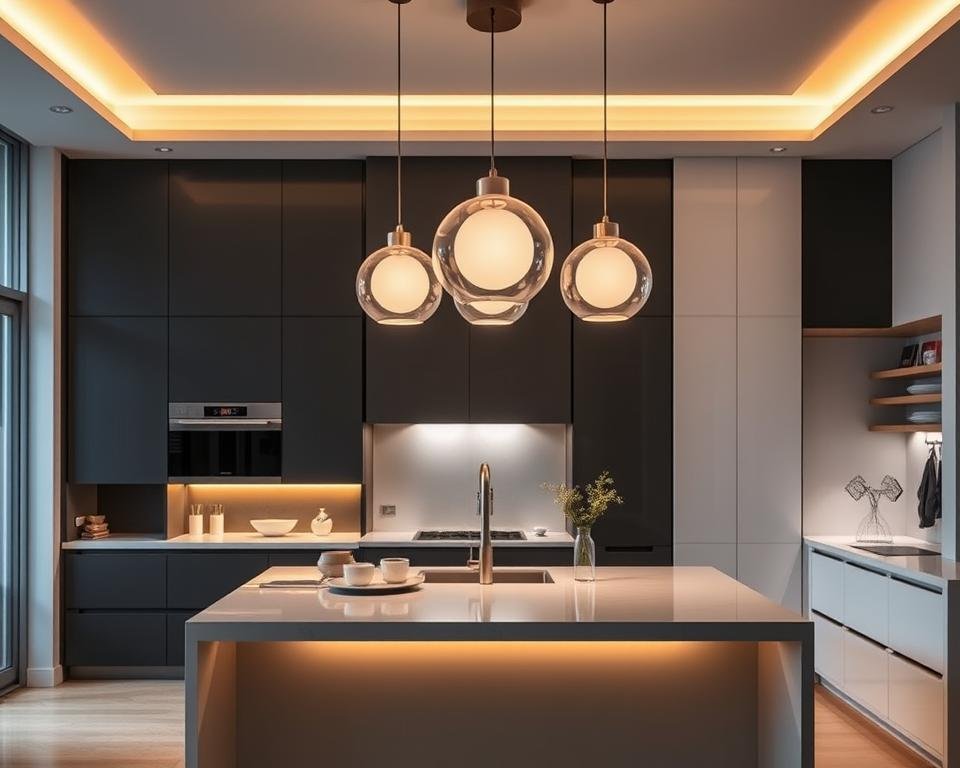
As we look for new and green ways to light our kitchens, 2024 will bring big changes. We’ll see kitchens that are not only bright but also smart and energy-efficient.
Pendant Lighting Solutions for Islands and Counters
Pendant lights are a great choice for kitchen islands and counters. They hang from the ceiling, bringing light right where you need it. They add elegance and can be a stunning focal point. With many styles and materials, they fit any kitchen look.
Selecting the Right Pendant Size
Think about the size of your space when picking pendant lights. Big islands need bigger or more lights to cover the area well. A good rule is to choose a light that’s about one-third the width of the surface.
Proper Height and Spacing Guidelines
Where and how you place pendant lights matters a lot. Hang them 30-36 inches above the counter for best light direction. For multiple lights, use the rule of thirds or odd numbers for a balanced look.
Style and Material Options
Kitchen pendant lights come in many styles, from modern to vintage. You can choose from glass, metal, or mixed materials to match your kitchen’s look. Finishes like black, bronze, and brass can also enhance your kitchen’s design.
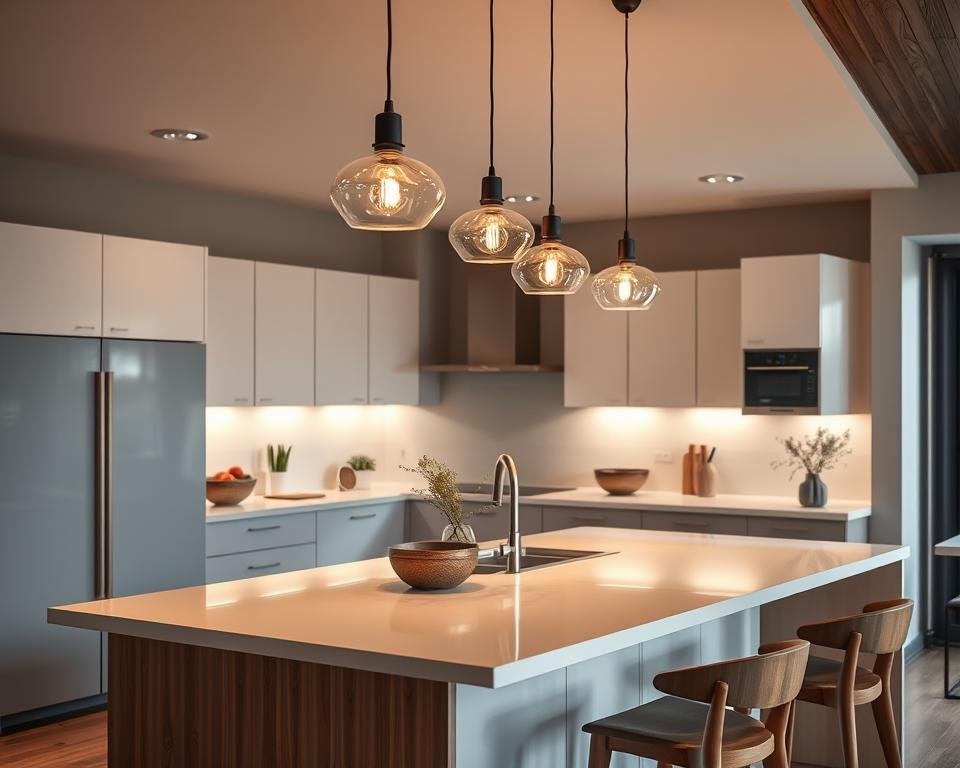
“Pendant lights offer an eye-catching focal point and are suited for the space above your island, kitchen table, bar area, and other spots that could benefit from extra light or a touch of beauty.”
Under-Cabinet Lighting Techniques
Make your kitchen better with under-cabinet lighting. These lights give you focused light for tasks and a soft glow for the area. You can choose from LED strip lights to puck lights, all designed to improve your kitchen’s look and feel.
Under-cabinet lights are great for lighting specific areas like countertops and backsplashes. They help a lot, making it easier for older people or those with vision problems to do everyday tasks.
- Strip lighting and puck lighting are the two main styles of under-cabinet lighting.
- Strip lights can cover the entire length of a cabinet box or utilize multiple shorter fixtures.
- Puck lights, typically 3-4 inches in diameter, offer a more dramatic and focused effect.
There are many ways to put in under-cabinet lights without them being seen. You can recess them, use a cover, or even go for battery-powered puck lights for DIY projects.
The finish of your countertop also matters. A polished surface will reflect light evenly, while a honed finish will give a softer, more textured look.
“Under-cabinet lighting is best added during the electrical roughing stage of a new build or kitchen renovation. This allows for a seamless, integrated look and easier installation.”
Adding under-cabinet lights and LED strip lights can change your kitchen for the better. It’s a smart choice for any kitchen, new or old. With the right planning, your kitchen will be more functional and welcoming.
Strategic Task Lighting Placement
Task lighting is key for a functional kitchen. It helps light up important areas and cuts down on eye strain. By placing lights right, your kitchen becomes a bright and productive place.
Food Prep Areas
For food prep, use recessed lights or pendant lights that you can adjust. These lights focus on the task at hand. They let you adjust the light to see ingredients and chop veggies clearly.
Sink and Stove Lighting
Sinks and stoves need their own lights. Use recessed fixtures or pendant lights above them. This ensures enough light to avoid shadows and see what’s cooking.
Counter Workspace Illumination
Counters are also important for task lighting. Under-cabinet lights or sconces work well here. They cut down shadows and eye strain, making your kitchen a better place to cook.
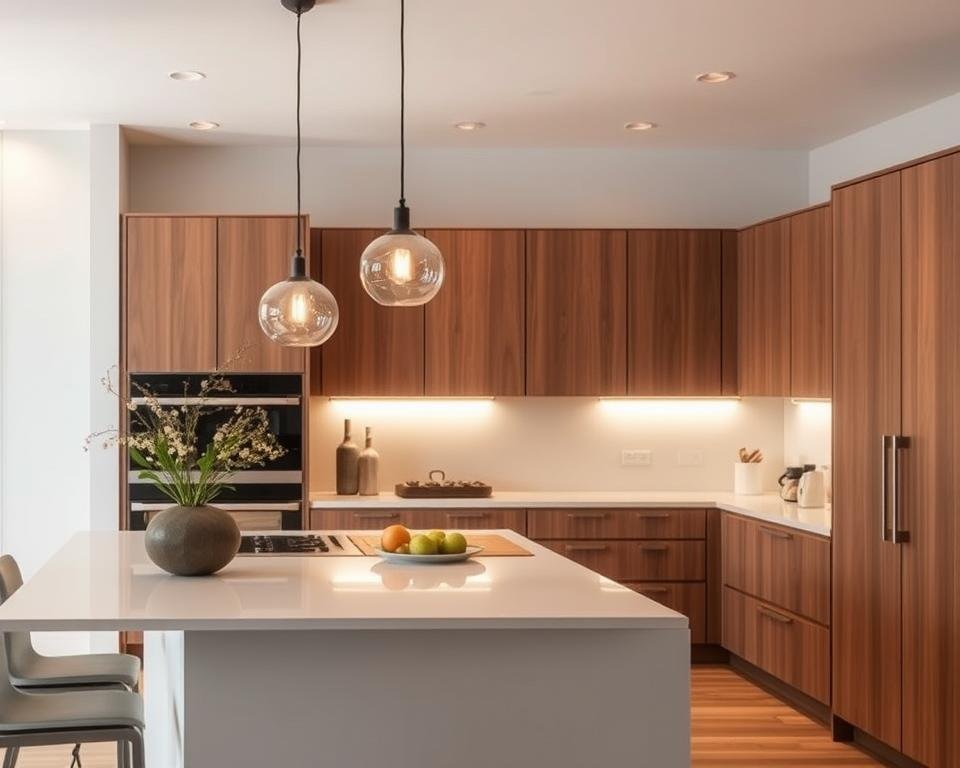
“Proper task lighting placement is key to creating an efficient and enjoyable cooking space. By illuminating specific work zones, you can reduce eye strain and make the most of your kitchen.”
Kitchen Lighting for Different Zones
Kitchen lighting is key to each area’s function and feel. The right lights can make your kitchen more inviting. It’s all about the zones, from cooking to dining.
In the cooking zone, bright task lighting is a must. Recessed lights or under-cabinet lights help with meal prep. The dining area, on the other hand, needs softer ambient lighting. Pendants or chandeliers create a cozy vibe.
Accent lighting highlights special features or display areas. Strategically placed wall sconces or strip lights add interest. They bring out the kitchen’s design.
For a well-lit kitchen, mix different lighting types. Recessed lights offer overall light, while pendants or chandeliers focus attention. Under-cabinet lights light up work areas. Dimmable switches let you adjust light levels for any time.
| Kitchen Zone | Lighting Type | Recommended Color Temperature |
|---|---|---|
| Food Preparation Area | Bright task lighting (recessed, under-cabinet) | Cool white (5000-6500K) |
| Dining Area | Soft ambient lighting (pendants, chandeliers) | Warm white (2700-3500K) |
| Pantry | Neutral lighting (recessed, wall sconces) | Neutral white (3500-4000K) |
Think about your kitchen’s zones and choose the right lights. This way, you’ll have a space that’s both functional and welcoming.
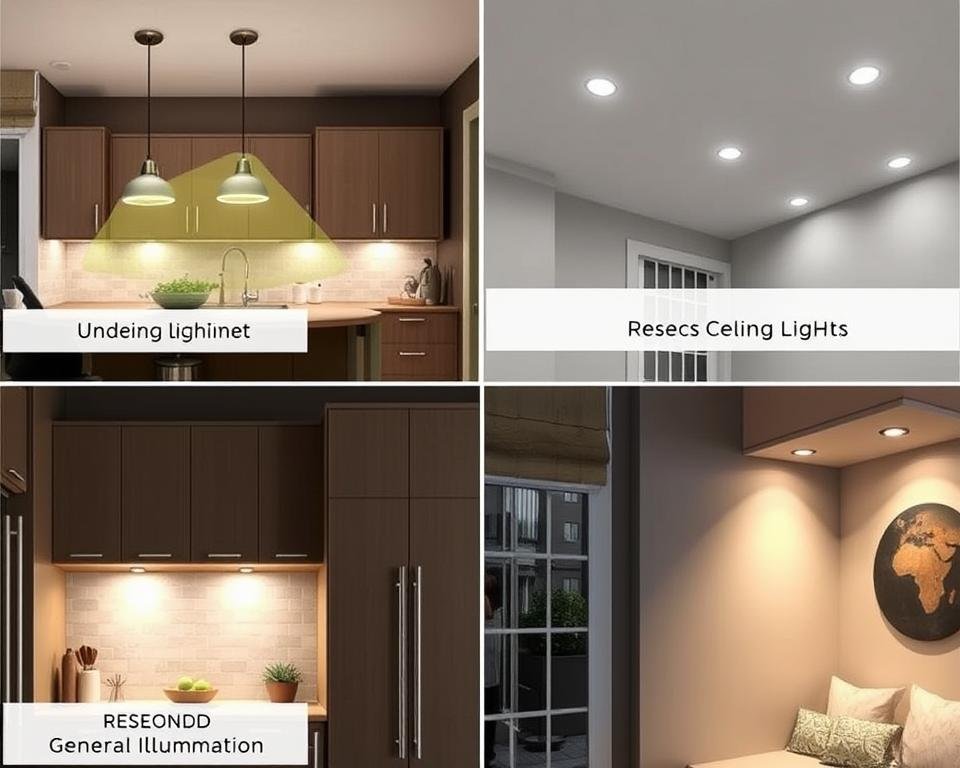
Chandelier and Statement Lighting Options
Chandeliers and statement lighting can be eye-catching in your kitchen. When picking a kitchen chandelier, think about the room’s size and ceiling height. A good rule is to choose a fixture that’s as wide as the room’s length and width in feet, turned into inches.
For style, look at your kitchen’s design. Modern kitchens might need sleek, geometric chandeliers. Traditional kitchens could do well with ornate, classic designs. The materials should match your kitchen’s finishes, like brushed gold, matte black, or natural wood.
Size and Scale Considerations
- A hanging dining room light fixture should be about 3′ from the top of the table.
- For round tables, the fixture size should be about ½ to ¾ the diameter of the table.
- In spaces with ceilings lower than 8′, a flush mount light can be used for dining room lighting.
Style Selection Tips
- Brushed gold pendant lights can help ground the kitchen island.
- A trio of pendants made of natural materials like antlers can add a rustic touch.
- A modern branched chandelier in a brushed black finish can provide ample light over the island.
- A semi-flush mount kitchen light with a whimsical modern-meets-retro feel can blend seamlessly.
The right kitchen chandelier or statement lighting can light up your space. It also adds character and elegance to your kitchen design.
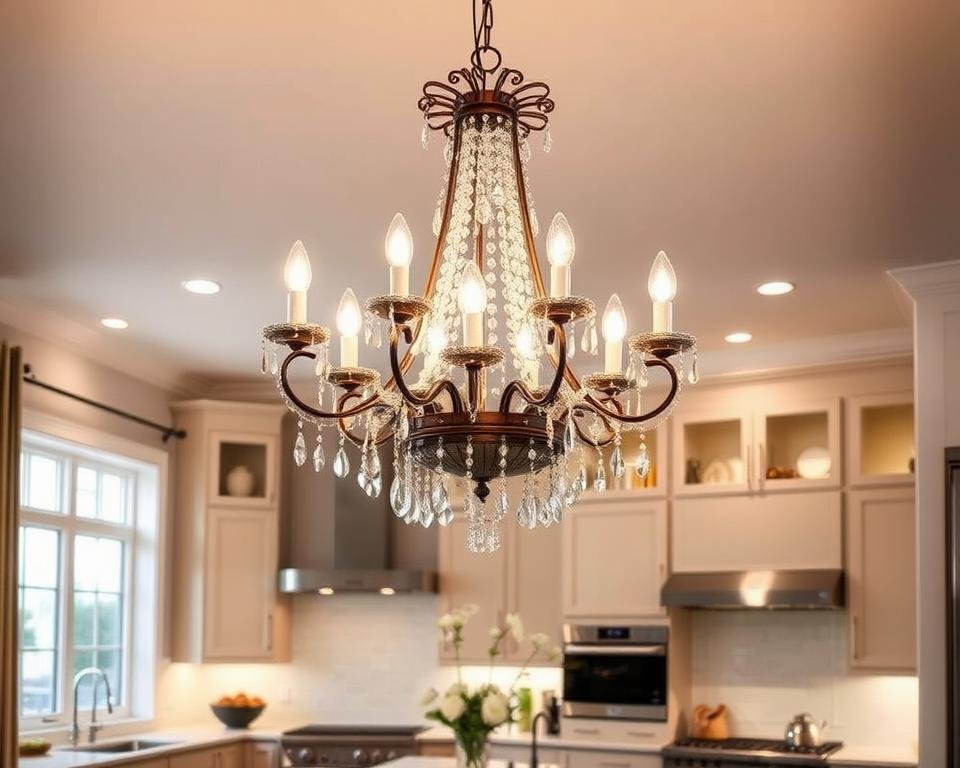
Energy-Efficient LED Solutions
LED technology is a top choice for kitchen lighting. Led lighting saves a lot of energy and lasts a long time. It comes in many styles, from recessed lights to decorative fixtures.
These lights give off bright, clear light and can change color. When picking LED lights, look at the color rendering index (CRI) for true color. Many also work with smart home systems for more control.
The perks of energy-efficient lighting are clear. By 2035, most U.S. lighting will be LED, saving a lot of energy. LEDs use much less power and last longer than old bulbs, making them a smart choice for kitchens.
“LEDs consume only a fraction of the energy required by traditional incandescent or CFL bulbs, resulting in significantly lower electricity bills.”
LED lighting saves money and looks great. It’s perfect for making a kitchen brighter or cozier. Energy-efficient LED options are the best choice for any kitchen.
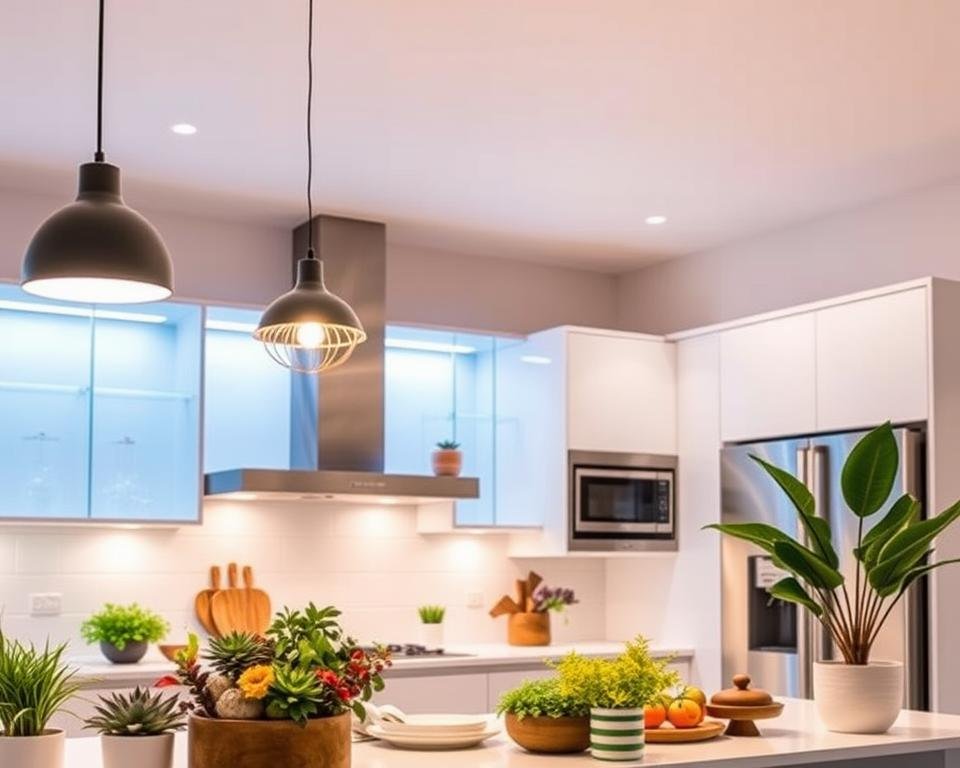
Smart Lighting Systems and Controls
In today’s kitchens, smart lighting systems offer advanced control and customization. These systems do more than just turn lights on and off. They let homeowners adjust lighting for any task or mood.
Dimming Capabilities
Smart lighting’s key feature is precise dimming. Dimmable lights let you change brightness levels. This is perfect for food prep or dinner parties.
With a tap or voice command, you can switch between bright task lighting and soft, cozy light.
Automated Lighting Schedules
Smart lighting systems also have automated schedules. You can set lights to turn on or off at certain times. This saves energy and keeps your home well-lit when you need it.
Whether you want your kitchen bright in the morning or dim for the evening, these routines make it easy.
Many smart lighting systems work with apps or voice assistants. This lets you control your kitchen lights from anywhere. It’s great for daily routines and helps those with physical challenges.
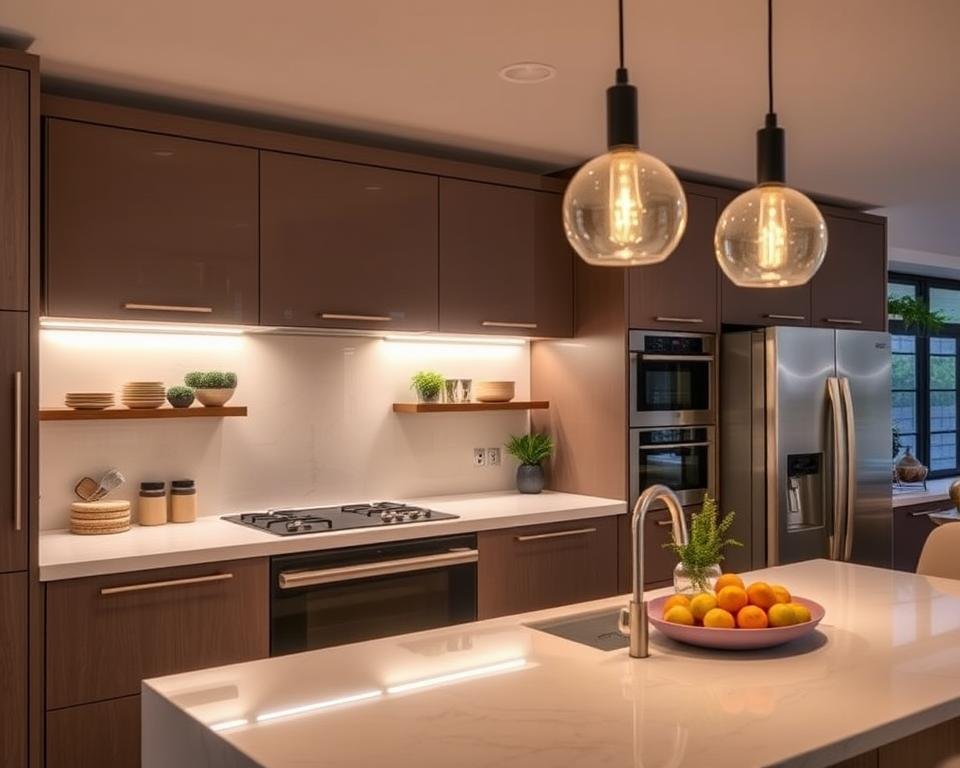
“Smart lighting systems have transformed the way I manage my kitchen. The ability to dim the lights and set automated schedules has made my space more functional and energy-efficient.”
– Jane Doe, Homeowner
| Feature | Benefit |
|---|---|
| Dimming Capabilities | Adjust brightness levels for different activities and moods |
| Automated Lighting Schedules | Enhance energy efficiency and convenience with customized lighting routines |
| Smartphone App and Voice Control | Manage your kitchen lighting from anywhere, with added accessibility |
Color Temperature and Mood Setting
Kitchen lighting’s color temperature is key for both function and feel. Cooler colors, from 4000K to 6500K, are best for task lighting. They give clear light that helps with food prep. Warmer colors, between 2700K and 3000K, make a cozy spot, perfect for dining or ambient lighting.
Many LED lights let you adjust color temperatures. This means you can change your kitchen’s mood as the day goes on. Mixing colors creates a lighting scheme that meets all your kitchen’s needs.
- Warm White color temperature (2700K – 3000K) is suitable for creating a cozy and intimate atmosphere in the kitchen.
- Soft White/Neutral Light color temperature (3500K – 4000K) is ideal for tasks requiring focus and precision in the kitchen and provides a modern, clean aesthetic.
- Bright White/Cool White color temperature (4000K – 5000K) is good for tasks requiring focus and precision in the kitchen and provides a modern, clean aesthetic.
- Daylight color temperature (5000K – 6500K) replicates natural daylight, promoting heightened alertness and ideal for workspaces and kitchens.
Knowing how color temperature affects your kitchen’s mood and function helps you choose the right lighting. It makes cooking better and adds to your kitchen’s charm.
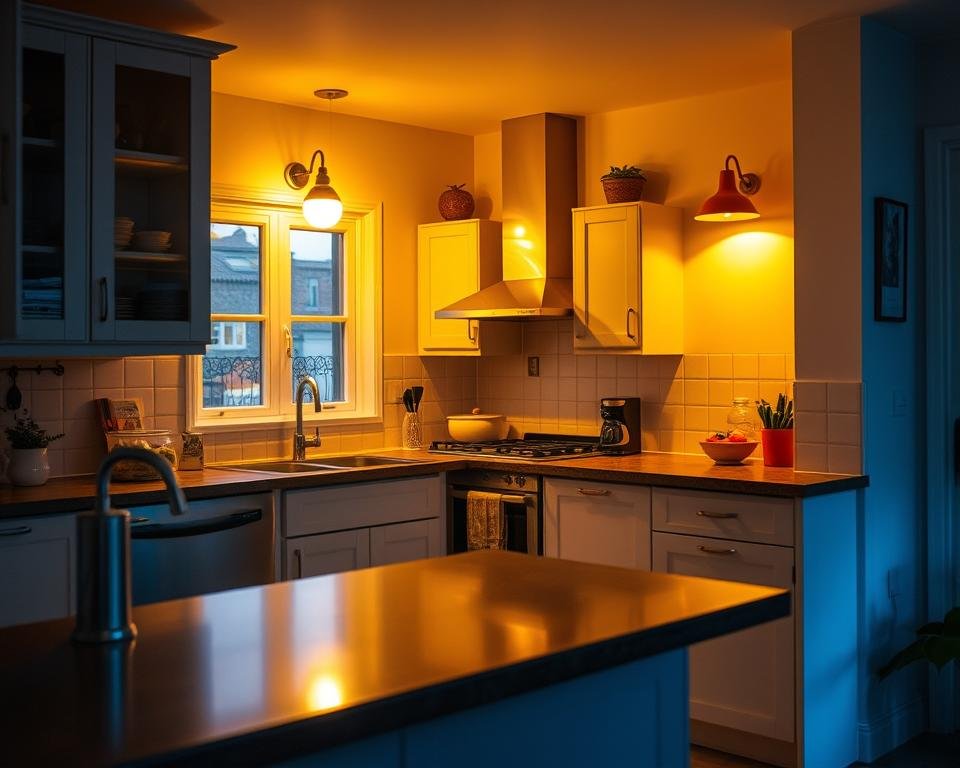
“The right color temperature can transform a kitchen from a utilitarian space into a warm and inviting haven.”
Budget-Friendly Lighting Updates
Updating your kitchen’s lighting doesn’t have to be expensive. With a bit of creativity and some DIY skills, you can change your kitchen’s look and feel. You won’t have to spend a lot of money.
DIY Installation Tips
One of the best ways to save money is to do the installation yourself. Replacing old fixtures or adding under-cabinet lighting is easy. Even if you’re new to DIY, you can do it with the right tutorials and online help.
This way, you save on labor costs. You can then use that money for better-quality fixtures.
Cost-Effective Fixtures
For budget lighting, focus on quality over quantity. Look for brands that offer good, long-lasting fixtures at fair prices. LED retrofits are a great choice. They can make your old lighting look new again without needing a full replacement.
Also, don’t be afraid to think differently. Thrift stores, flea markets, and online sites have unique, budget-friendly lighting options. You can find something special and fix it up to fit your style.
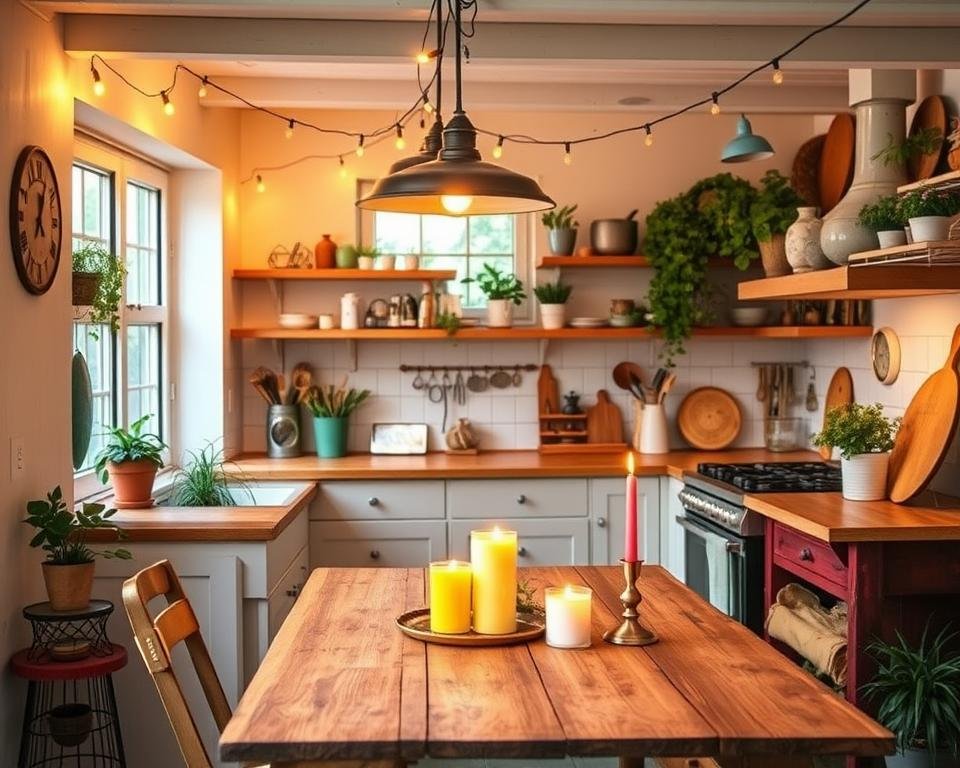
By using smart DIY methods and choosing affordable fixtures, you can make your kitchen look fancy. With some effort and a good eye for design, you can update your kitchen lighting without spending a lot.
Natural Light Integration
Maximizing natural light can make your kitchen brighter and more welcoming. By using natural light sources wisely, you can make your kitchen more efficient and stylish. Let’s look at how to bring more light into your kitchen.
Adding or enlarging windows is a great way to let in more light. Positioning windows right can make your kitchen feel warmer and brighter. In places like Phoenix, windows facing south can help save energy by using the sun’s heat in winter.
Skylights are also great for adding light to your kitchen. They can make even dark areas feel open and airy. When picking skylights, think about their size, where they go, and if they save energy to fit your kitchen and climate well.
- Use light-colored surfaces like countertops and floors to reflect more light.
- Place task lights, like under-cabinet lights, to work with natural light and light up work areas.
- Choose window treatments that let in light but also keep things private for comfort.
By adding natural light to your kitchen, you make it look good and save energy. Natural light can turn your kitchen into a bright, welcoming, and useful part of your home.
| Benefits of Natural Light in Kitchens | Strategies for Maximizing Natural Light |
|---|---|
|
|
“Natural light is a key part of kitchen design, making it brighter and more welcoming. By adding natural light, you can make your kitchen more functional, efficient, and attractive.”
– Jane Doe, Interior Designer
Conclusion
Effective kitchen lighting is a mix of function and beauty. It turns the kitchen into a welcoming and useful space. By learning about kitchen lighting, following the latest trends, and meeting different needs, homeowners can make their kitchen bright, efficient, and stylish.
Choosing the right lighting, like smart tech or energy-saving LEDs, can make the kitchen feel better and work better. Using natural light, task lighting, and accent lighting makes the kitchen look good and fit your life.
There are many choices for kitchen lighting ideas and lighting design. From pendant lights to dimmable controls, the options are endless. By using these tips, homeowners can make their kitchen the heart of the home. It will be both useful and welcoming.
FAQ
What are the main types of kitchen lighting?
Kitchen lighting comes in three main types. Task lighting focuses on work areas. Ambient lighting gives overall light. Accent lighting highlights special features.
Why is layered lighting important in kitchens?
Layered lighting mixes different lights for a dynamic look. It includes primary lights, island lights, cabinet lights, and accent pieces. This setup is versatile for various activities and moods.
What are some of the key 2024 kitchen lighting trends?
In 2024, kitchen lighting trends focus on energy saving and smart tech. Expect to see more LED lights, pendant lights, and mixed materials like antique brass and clear acrylic.
How do you choose the right pendant lights for a kitchen island or counter?
Pick pendant lights based on the island or counter size. Hang them 30-36 inches above the surface. Use odd numbers for a balanced look.
What are the benefits of under-cabinet lighting?
Under-cabinet lighting shines a focused light on prep areas. It also adds a soft glow. LED strip lights are slim, energy-efficient, and come in various colors and brightness levels.
Where should task lighting be placed in the kitchen?
Task lighting is key in kitchen zones like food prep, sink, stove, and counter workspaces. It ensures bright light and prevents shadows.
How can different lighting zones be addressed in the kitchen?
Kitchen lighting should cover different zones. Cooking zones need bright task lights. Dining areas need softer lights. Accent lights highlight features or displays.
What factors should be considered when choosing a kitchen chandelier?
Choose a chandelier based on room size, ceiling height, and kitchen design. Ensure it complements materials for a focal point.
What are the benefits of LED lighting in the kitchen?
LED lights save energy and last long. They offer bright light and adjustable colors for different needs.
How can smart lighting systems enhance kitchen lighting?
Smart lighting systems offer control and customization. They include dimmable lights, schedules, and integration with smart home devices for convenience and energy saving.
How does color temperature affect kitchen lighting?
Cooler colors (4000K-6500K) are best for task lighting. Warmer colors (2700K-3000K) create a cozy feel. Modern LEDs allow adjusting color temperatures for different moods.
How can homeowners update kitchen lighting on a budget?
Update lighting on a budget with DIY under-cabinet lights, replacing fixtures, and finding unique, affordable lights at thrift stores or flea markets.
How can natural light be maximized in the kitchen?
Boost natural light by adding or enlarging windows, installing skylights, or using light tubes. Combine with artificial lighting for a well-lit, energy-efficient kitchen.



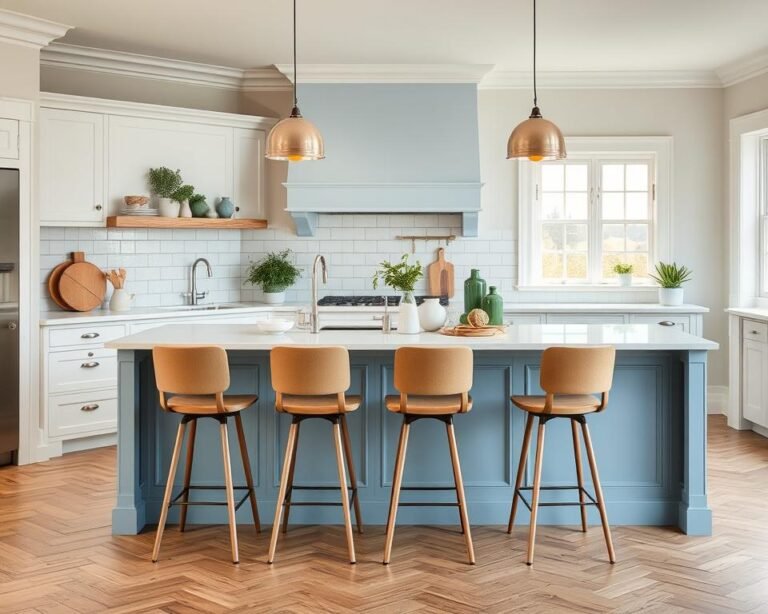
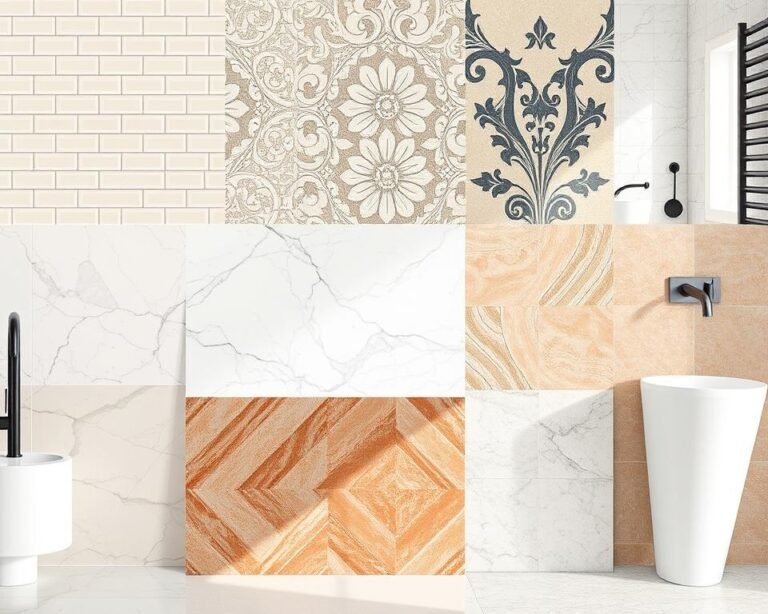
Leave a Comment